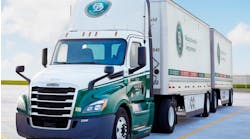Succession planning can be good for your company's future and present
KISSIMMEE, FL. Nobody owns a business forever. Whether you’re planning to pass your company along to your children, your employees or the highest bidder, it is never too early to start planning, according to Spencer Tenney, the managing partner of the Tenney Group, a certified merger and acquisition adviser in North America dedicated exclusively to the transportation industry.
All transportation companies are going to transfer ownership inside or outside the family at some point – “either by choice or by force,” Tenney told a crowd of trucking executives during the 80th annual TCA Convention: The Future of Truckload. “Some of us today have a hope that our son or daughter will carry the business into the next generation. Maybe you have an idea or goal of transitioning ownership to your employees through and employee-stock-ownership plan (ESOP). But you know what happens? Life happens. Plans change all the time.”
But that doesn’t make succession planning a waste of time, Tenney said. “In the absence of succession planning, we create owner dependence. And owner dependence equals high risk. High risk equals discounted business valuation. In other words, your business is worth less than it otherwise could be. Discounted valuation equals few options. That means few options to promote the interest of yourself, your family and your employees, and your legacy.”
The solution, Tenney said, is not in a plan, it’s in the process. He shared what he called the seven best practices for succession planning. “My hope is that as you go through this process, we are going to create some additional enthusiasm and some interest.”
1. Establish where you are
Tenney said it all starts with a third-party business valuation. “You have to establish a baseline,” he said, stressing that it be an unbiased view from someone with trucking knowledge and experience. “We want to make sure we have a solid foundation before we start doing all the work here.”
He said it’s important to have your accountant figure out what your business would be worth if you sold it today and share that information with your wealth adviser to help you see how it can help you achieve your retirement goals.
2. Discuss business value and plans with family members/potential successors
It is important to start an open dialogue with the next generation about the facts surrounding the business and that can help you figure out who wants to be considered a successor, Tenney said. “What that does is it gets the conversation started,” he said, noting that unless you have that conversation, uncertainty rules.
He also suggested using a third party for this discussion because you’re more likely to get authentic feedback. “It has been my experience that you don’t always get authentic feedback on the first go-round, but over time as you go through more, you get really authentic feedback – and that’s the point,” Tenney said.
These discussions also lead to opportunities for potential successors to step up and play a larger role in the company and equip that person. “Maybe they have a desire but they don’t have the skills yet,” Tenney said. “Going through Step 2 gives you the ability to acknowledge that and start training and equipping that person to be a potential person who could take your business to the next level.”
And through the discipline of doing this process regularly, you will find that goals change, Tenney said. Someone who was planning years ago to be a successor might have their own situation change, for example. You also might find that a child or employee looking to take over needs management or other training.
3. Establish goals for business ownership transfer
When you develop your goals for the business, there should also be a “why” next to the goals, Tenney said. “What does it do for you? How does it promote the interest of your family, your business, your legacy?” he asked. “You should be able to tie it back and there should be some evidence. Because sometimes, depending on how profitable your business is, multiplying trucks, just multiplies the problems. So we want to make sure there is some depth to those answers. It also gives us the ability to measure where we’re going. We’ve got our actuals; we’ve got our goals. And that lays the groundwork for what we’re doing from a strategy standpoint moving forward.”
4. Identify/quantify gaps between goals and actuals
The assumption is that if you do certain things for your company, your value will go up, Tenney said. “When we’re in a capital-intense industry, sometimes it isn’t that simple,” he said. “Because as your value goes up, so does the required debt to support that value. So what we’re talking about is net proceeds from a potential sale as we’re building value in a business.”
So you have to define that gap between your goals and what you have and how you will close that gap. Tenney broke down closing the gap into “four buckets:”
- Time: How much time do you have available? “Depending on what that is, is going to make a big difference in what we do.”
- Capital: What type of capital do you have “to move the needle to enhance the value of our business?”
- Energy: “Doesn’t sound like a big deal but that’s about as important currency as anything else in the business. If you have all these good ideas but you don’t have the energy to go execute, then No. 1 and No. 2 don’t matter anyways.”
- Appetite for risk: “You may have time, you may have capital, you may have energy, but depending on what season of life you’re in – I don’t know what you have experience but when I’m talking to folks in this industry, people’s appetite for risk at age 40 is very different than age 70. Very different.”
Those, Tenney said, are the tools you have to work with. “And depending on the answers to all those questions, that is how we begin developing strategies to move the needle.”
5. Consider available transfer channels
In general, business owners have a lot more options – than what they typically consider – to accomplish their goals.
“Depending on where you are in your financial security, you have a much deeper playbook in terms of what you can do,” Tenney said. “It’s when folks are depending on their financial security and retirement funds from the potential transfer of ownership when it becomes a little more sensitive about how this is executed.”
Among those options are selling to an employee or using employee-stock-ownership plan, selling or gifting to family, partner buyouts for co-owners (“One of the easiest deals to finance and actually get money,” Tenney noted), selling to an outside party, recapitalization (selling 30%-80% to private equity and keeping some interest in the company) or going public.
When asked about gifting the company to children, Tenney said it can be tricky and is not something he advises, particularly if you need money for retirement or if you are going to evenly split control of the company among children with various interests in the business.
“There’s nothing wrong with gifting – but make sure it’s a gift,” Tenney said, noting that gifting your company to multiple relatives could create problems down the road. “Make sure it’s a gift because fair is not equal and equal is not fair when it comes to transferring ownership to kids.”
Whatever you end up doing should depend on what your goals are, Tenney stressed.
6. Rinse and repeat annually through a third-party facilitator
Tenney said it’s important each year to look again and see where you stand and if yours or your potential successors’ values or goals have changed. Life can change overnight, he noted.
“Just because something might be the best fit, doesn’t mean there isn’t work to be done,” he said. “You need to be cultivating opportunities that can actually be put into fruition… If you don’t develop needed relationships, you aren’t giving yourself options.”
7. Act: Be a hero
“For many business owners, making money is not the primary objective,” Tenney said. “There’s a lot more at stake in terms of legacy and things of that nature. It’s my belief, based on what I’ve experienced in selling companies over the past 15 years, is money alone will almost always fail to make someone take action.”
He said he’s seen business owners talk about taking money but not pull the trigger just for money because they are too invested in their community and their legacy.
“In these seven best practices, what I hope you’re gathering from this is it’s not about the money – that’s the point,” Tenney said. “But if you don’t do this process, you can’t take care of the money and you can’t take care of the legacy either. You don’t have any control.
If you go through this process and you follow these seven best practices, you will insulate the people you care about the most from the disruptions of the trucking industry. “No matter what is going on, if you take care of business, you’ll always have options to execute your plan.”
And that will make you a hero, Tenney said.
“It’s work but it’s also a path to a better life,” he said. “When you start getting more people involved in what you’re doing, they’ll make your business better. They’ll make your life better. Those are all good things.”
Tenney stressed focusing on what you can control and be flexible on your timing. “If you’re doing these things and opportunity comes to your doorstep – even if it doesn’t fit into your idea, your time frame or your plan – just be flexible,” he said. “Because ultimately, that flexibility might be exactly what allows you to promote the interests of your family, your employees and your community.”
He also encourages company owners to measure their success in relationships: “When you’re doing this, think about how you want Thanksgiving dinner to look over the next five to 10 years… how you handle this is far more significant than whatever result you might do on your own.”




